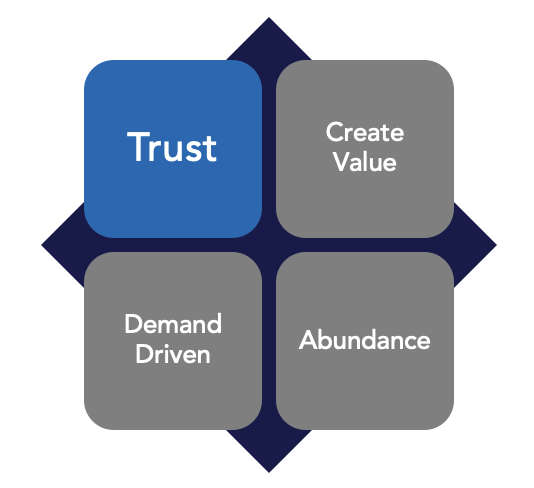Trust
Engage, empower, motivate.

Design from a basis of trust: enable the most capable. Don't accommodate the least capable. Deal with the least capable as exceptions and improve their capabilities through training and coaching.
What if we trusted you? Jerry Michalski, a long-time friend, and contributor to the Consortium's thinking introduced us to the "design from trust" concept. Jerry's Ted talk is here.
Trust is so powerful. It is a prerequisite for engaged and inspired employees (knowledge workers). When trust is present, people do better work and more of it. When it is absent, it is a source of great dysfunction.
As Stephen M. R. Covey points out in his book The Speed Of Trust: the One Thing That Changes Everything, trust increases speed and reduces cost. And, the absence of trust is a frequent and significant source of dysfunction within a team, as described in Patrick Lencioni's book The Five Dysfunctions of a Team.
Trust shows up in many ways:
- As employees, do we trust our leadership?
- As leaders, do we trust our employees?
- Do we trust our peers?
- Do we trust we are being measured fairly and will be recognized for our contribution?
- Do we trust that our institutions (government and business) are competent and ethical?
The answer must be yes to each of these questions for a healthy, productive environment with engaged employees.
Sadly, Gallup reports that 68% of the United States workforce is not engaged in their work. Gallup defines engaged employees as "those who are involved in, enthusiastic about, and committed to their work."
Trust is reciprocal. That is: trust begets trust. If I show trust in you, you are more likely to trust me. Most organizational policies and processes are designed to accommodate the weakest performer on the team. They are often designed from a basis of mistrust. While that may help to minimize the damage the least capable employees do, it dramatically diminishes the engagement of those who are the most capable. It minimizes the ability of the strongest to contribute in creative ways. Employees' sense of autonomy is a key factor in motivation and engagement. Overly onerous and restrictive processes do not create a sense of autonomy; they promote disengagement, especially for our most talented and capable employees.
The Leadership Challenge
Trust is one of those things that takes weeks and months to build and seconds to destroy. Trust starts at the top of the organization. It is the executives' responsibility to create an environment or culture based on trust. As executives define and articulate a vision for the organization, the message must be consistent over time. We have defined the elements of a vision as a compelling purpose, mission, values, and brand promise (for more on a vision, see the "Create Value" principle). Leaders must consistently behave in a way that aligns with and models the vision. The fastest way to destroy trust in an organization is a disconnect between the stated vision and the executives' behaviors and decision-making. The deck is stacked against today's leaders based on employees' past experience. Research shows that employees' view of leadership integrity is very low.
Additionally, the Edelman Trust Barometer, which has been tracking indicators of trust for the past 20 years, points out the factors that play a role in employees' assessment of executive trustworthiness have expanded beyond the organizational boundaries to include social and societal issues. For leadership, this increases the difficulty of an already challenging task.
For leaders, trust is the degree to which they believe that employees are capable of making good decisions and judgments. It's the belief that, given the right information and an understanding of the organization's purpose, mission, values, and brand promise, people will do the right thing based on the situation. This is especially critical in engaging knowledge workers and those who interact with customers.
For employees, trust relates to believing leadership is truly committed to the vision and has the employees' interests in mind. Employee must believe that they will be recognized for their contribution to their team and the organization, and that the appropriate processes and infrastructure are in place to capitalize on their collective experience. Employees must feel they have access to the best information and tools available. Sustaining knowledge worker engagement requires that leadership provide them with constant visibility to the impact of their contribution.
Summary
Trust, as a cultural attribute, is a critical success factor in an organization's ability to maximize and sustain the benefits of the transformational methodologies of the Consortium. Apathetic or unengaged employees are death to any transformation initiative.
References
- Gallup: Employee engagement
- Current Edelman Trust Barometer
- The Speed of Trust by Stephen Covey
- Design from Trust - Jerry Michalski

